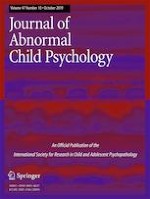25-04-2019
Emotional Underarousal and Overarousal and Engagement in Relational Aggression: Interactions between Relational Victimization, Physiological Reactivity, and Emotional Sensitivity
Gepubliceerd in: Research on Child and Adolescent Psychopathology | Uitgave 10/2019
Log in om toegang te krijgenAbstract
The present study examined if overarousal (i.e., dysregulation and high emotional sensitivity) and underarousal (i.e., fearlessness and emotional insensitivity) to peer stress, reflected in physiological reactivity and subjective emotional sensitivity, exacerbated risk for relational aggression in relationally victimized children. Participants were a community sample of 125 children (10–12 years, M = 11.34 years, SD = 0.89; 45% female). Teachers provided ratings of children’s relational victimization and relational aggression. Children’s physiological reactivity was assessed based on skin conductance level (SCL) reactivity and respiratory sinus arrhythmia (RSA) reactivity to a standardized peer rejection task. Children’s subjective emotional sensitivity was assessed using self-reported ratings of distress to hypothetical relational provocation vignettes. Results indicated that relational victimization was significantly associated with relational aggression only for children with high SCL reactivity and high emotional sensitivity (i.e., physiological and subjective overarousal) and for children with low SCL reactivity and low emotional sensitivity (i.e., physiological and subjective underarousal); relational victimization did not predict relational aggression among children with high SCL reactivity but low emotional sensitivity or among children with low SCL reactivity but high emotional sensitivity. Relational victimization was also marginally more strongly associated with relational aggression for children displaying RSA augmentation. Results suggest emotional overarousal and underarousal may both serve as vulnerabilities for relational aggression among relationally victimized youth, and underscore the importance of including physiological and subjective indices of emotional reactivity in studies of aggression. Implications for theory and intervention are discussed.
